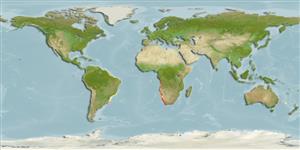>
Gadiformes (Cods) >
Macrouridae (Grenadiers or rattails)
Etymology: Kuronezumia: Japanese, kuronezumia = black mouse or rat. Personnal communication of Tomio I. Curator in the Calif. Academy of Sciences, Ichthyology.
More on author: Barnard.
Issue
Genus Eschmeyer, pers. comm.
Environment: milieu / climate zone / depth range / distribution range
Écologie
marin benthopélagique; profondeur 161 - 850 m (Ref. 11953). Deep-water; - 35°S
Southeast Atlantic: Namibia and off Cape Point, South Africa. Also southwest Atlantic.
Taille / Poids / Âge
Maturity: Lm ? range ? - ? cm
Max length : 50.0 cm TL mâle / non sexé; (Ref. 11953)
Épines dorsales (Total) : 2. Brownish in color.
A benthic species found on the continental slope (Ref. 75154). Minimum depth reported from Ref. 27121.
Life cycle and mating behavior
Maturité | Reproduction | Frai | Œufs | Fécondité | Larves
Iwamoto, T., 1986. Macrouridae. p. 330-341. In M.M. Smith and P.C. Heemstra (eds.) Smiths' sea fishes. Springer-Verlag, Berlin. (Ref. 2800)
Statut dans la liste rouge de l'IUCN (Ref. 130435: Version 2024-1)
Menace pour l'homme
Harmless
Utilisations par l'homme
Outils
Articles particuliers
Télécharger en XML
Sources Internet
Estimates based on models
Preferred temperature (Ref.
123201): 7.3 - 14.3, mean 9.4 °C (based on 36 cells).
Phylogenetic diversity index (Ref.
82804): PD
50 = 0.5312 [Uniqueness, from 0.5 = low to 2.0 = high].
Bayesian length-weight: a=0.00214 (0.00109 - 0.00421), b=3.20 (3.03 - 3.37), in cm total length, based on LWR estimates for this (Sub)family-body shape (Ref.
93245).
Niveau trophique (Ref.
69278): 3.6 ±0.5 se; based on size and trophs of closest relatives
Résilience (Ref.
120179): Faible, temps minimum de doublement de population : 4,5 à 14 années (Preliminary K or Fecundity.).
Fishing Vulnerability (Ref.
59153): Moderate vulnerability (40 of 100).
